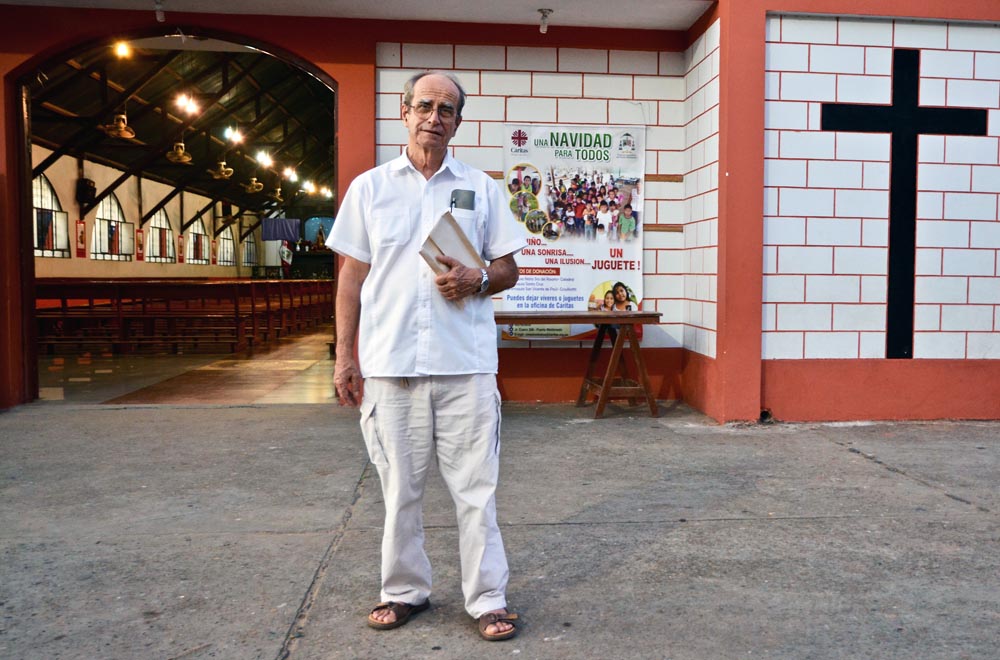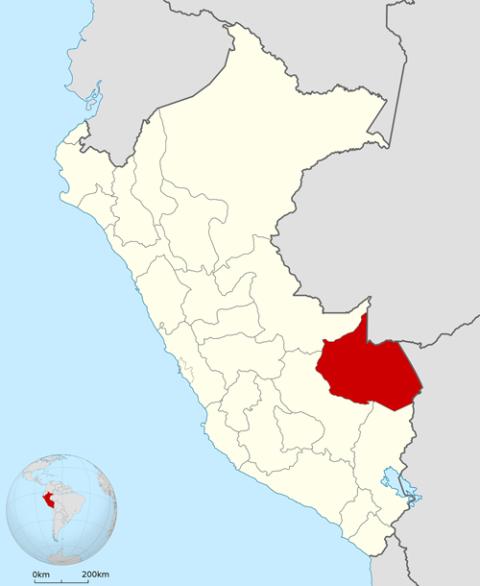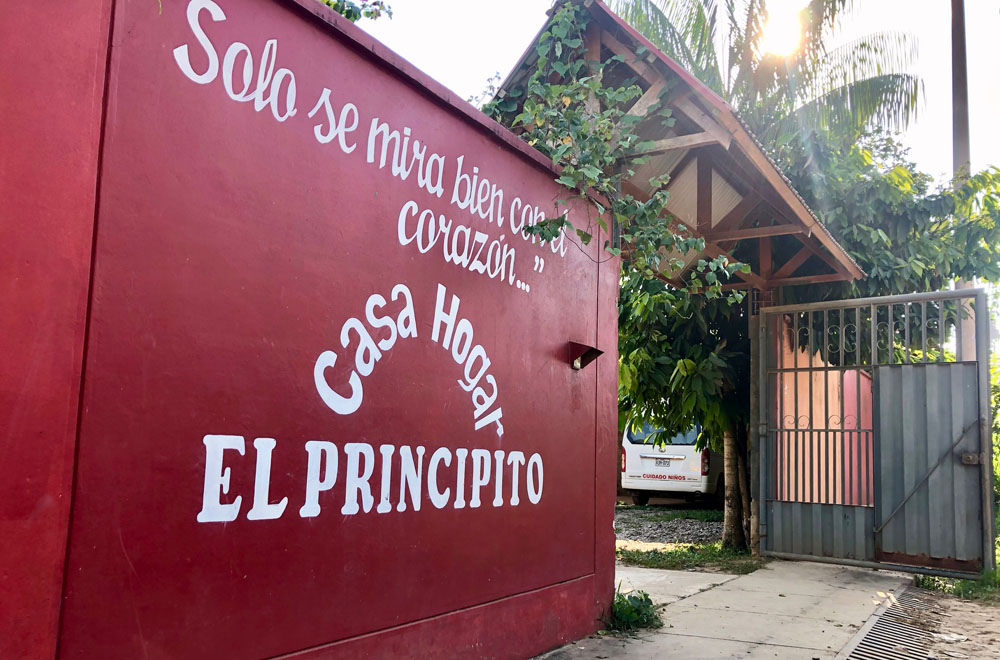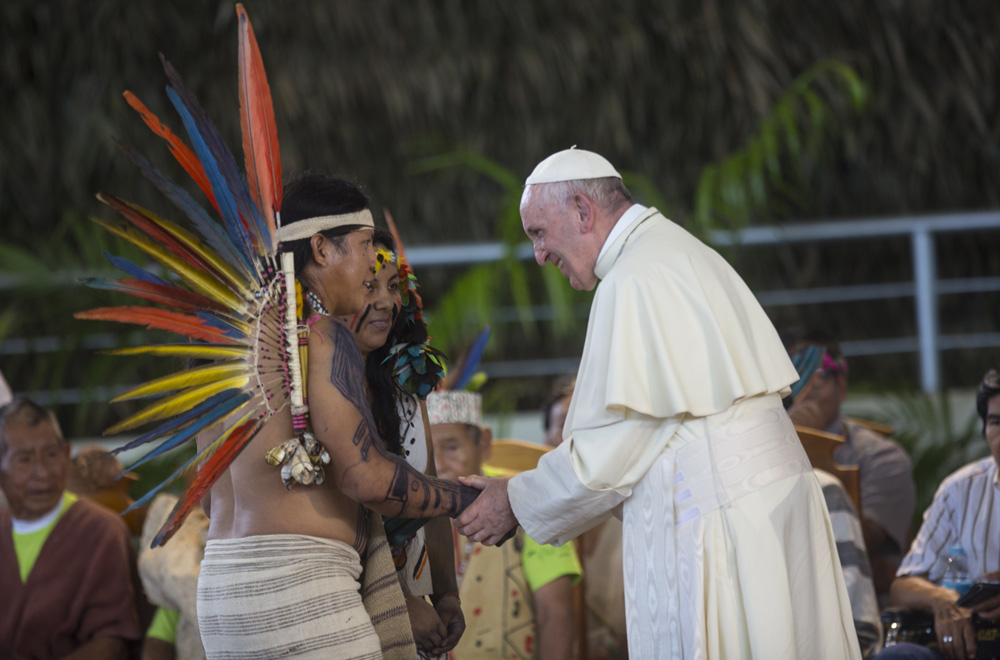
Aerial shots where forests were destroyed by illegal gold miners in the Madre de Dios state of Peru. (RNS/Paula Dupraz-Dobias)
Pope Francis' trip to Peru a year ago included a visit to a biodiverse region, where a Swiss priest has for decades sought to bring global attention to environmental and social devastation caused by illegal gold mining.
Despite years of effort — and the pope's visit — little has changed, said Xavier Arbex.
"It's so frustrating, to the point that I almost do not want to receive journalists anymore," the 75-year-old priest told Religion News Service recently.
Arbex has seen and heard much in the more than four decades he's lived in Peru. When the diocesan priest first arrived 1974, he began working in Puno, a mining region where indigenous people scrape a living in the shadows of the country's extensive mineral wealth. Peru is the world's second-biggest copper and silver producer, and the sixth most important source of gold.

Fr. Xavier Arbex at the Señor de Qoyllority parish church in Puerto Maldonado, Peru (RNS/Paula Dupraz-Dobias)
Twenty years ago, he moved to Peru's southeastern Amazonian region of Madre de Dios, to set up a children's home called El Principito. After arriving, he learned that most of the country's illegal gold is produced in the area, representing a multibillion-dollar business estimated to be more profitable now than the drug trade.
Soon after he resettled in Puerto Maldonado, Arbex said, he began warning local leaders and journalists of impending social and environmental issues.

The department of Madre de Dios in southeastern Peru (Map courtesy of Creative Commons)
Wildcat miners who first panned gold from riverbanks began moving heavy machinery into Madre de Dios and cutting down thousands of hectares of forest as global prices for the mineral rose.
Mercury used in the mining operations — some 90 metric tons annually, according to the Canadian group Artisanal Gold Council — exposes local inhabitants and indigenous populations to high levels of the heavy metal in their blood.
Tens of thousands of hectares of pristine jungle are transformed every year into barren, sandy wastelands. In 2017, the government estimated 208 square kilometers (80 square miles) of forest were lost.
The illegal activity directly employed some 50,000 to 70,000 people in the region, according to estimates by the Peruvian national ombudsman La Defensoría del Pueblo in 2014. Additionally, nongovernmental organizations say thousands of girls are lured, often unwillingly, into the sex trade.
"I warned everyone that this would happen," Arbex said. "But no one wanted to listen."
In 2006, the priest published an article that condemned the exploitation of freshwater, land and people for the excavation and separation of gold ore. Arbex criticized government ministries and NGOs for not playing their respective roles to control the situation at the time.
"This generation's life is causing death for the following generation," he wrote.
The priest claims that in La Pampa, a vast lawless area not far from Puerto Maldonado, at least 250 workers go missing every year.
"Sometimes they are buried alive in a mudslide set off by water jets (that separate the soil from the gold)," he explains. "And they are just left there."
Guimo Loaysa, who heads the national ombudsman's regional office, told RNS that "there was no way to document" the numbers of people who go missing. "Everything is informal (in this region). There is no way to look for these people either by their families or by the police. Often there is no interest to find them."

Fr. Xavier Arbex started the El Principito children's home in Puerto Maldonado, Peru, in the late 1990s. (RNS/Paula Dupraz-Dobias)
El Principito, located a few minutes from the center of Puerto Maldonado, houses 35 young residents, ages 4 to 20. Most were abandoned by their families or escaped sexual, physical or psychological abuse. Others were brought to the home by single mothers who work at the mines and were eager to assure their safety.
At El Principito, Arbex said, residents form a "big family." They attend school and later university, go to friends' parties and music classes, as well as receive assistance from social workers and psychologists.
Support for the home comes from private contributions to La Apronia, a nonprofit association founded by Arbex, and profits earned at "solidarity ventures," which include a popular ice cream parlor, Gustitos del Cura (the Priest's Flavors), located on Puerto Maldonado's main square.
On arriving in Peru in January 2018, the pope focused on his support for environmental preservation.
"Forests, rivers and streams are exploited mercilessly, then left barren and unusable," Francis said. People, too, he said, are "used until someone gets tired of them, then abandoned."
The pope thanked Arbex for his "example" and social work with the young victims of mining.

Pope Francis greets indigenous representatives Jan. 19, 2018, in Puerto Maldonado, Peru. Standing with thousands of indigenous Peruvians, Francis declared the Amazon the "heart of the church" and called for a three-fold defense of its life, land and cultures. (RNS/AP/Rodrigo Abd)
Arbex said he has fond memories of the pope's visit.
"I will keep an uplifting memory," he said.
But a year later, Arbex is frustrated that little has changed with regard to illegal mining. The region produced 13 metric tons of gold in 2017, according to the National Society of Mining, Oil and Energy.
"Not even a single study group or environmental impact project was created here at a local institution," he said. "I haven't seen any effects of the papal visit."
Still, the pope's visit did benefit Arbex's work with children.
Because of the publicity around the visit, Arbex was able to raise funds to renovate the ice cream parlor, which helps support the work of El Principito.
"At least the children's home is better known now," he said.
Advertisement



